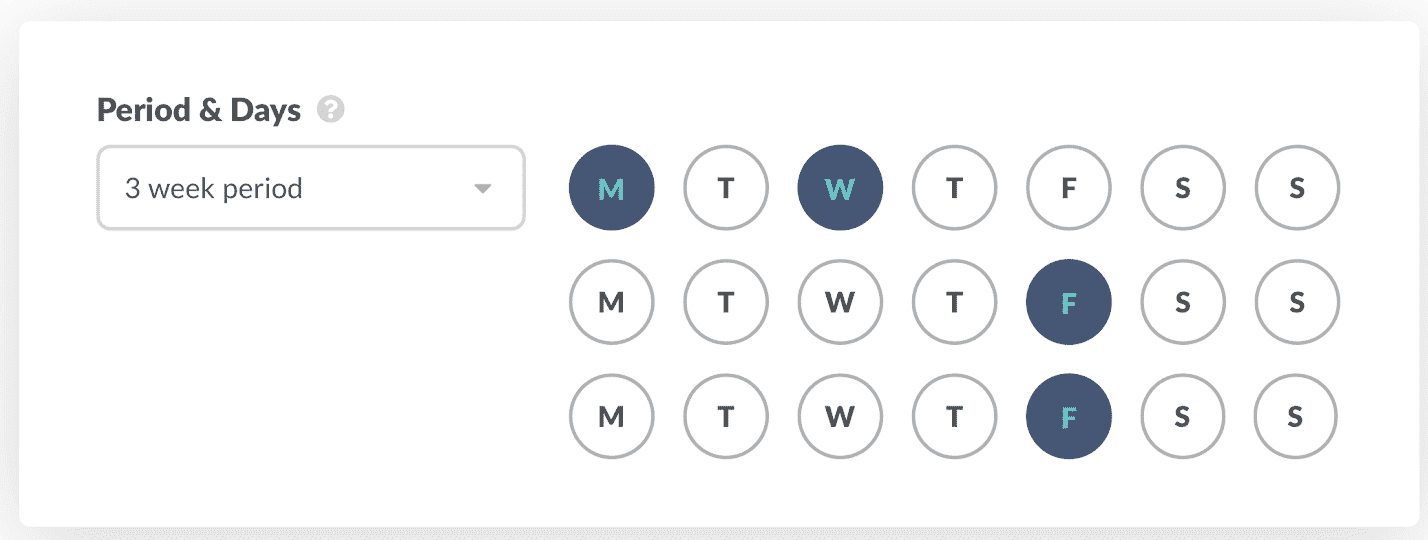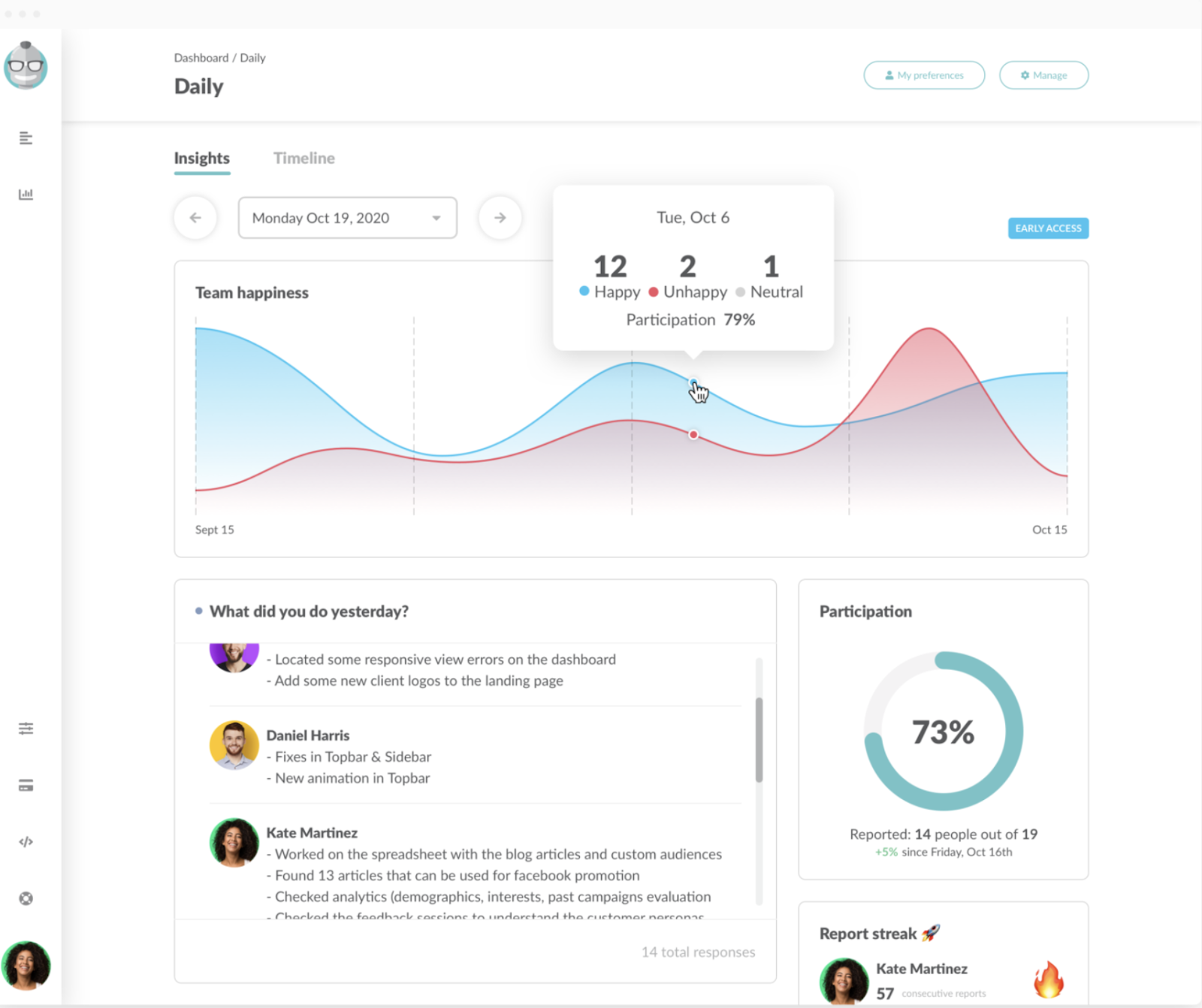As many teams (including our own) have experienced, synchronous standups are responsible for some of the more common daily scrum anti-patterns.
- They are difficult to schedule. From accommodating remote teams across different time zones to calendar clashes to last-minute availability changes, it’s an ongoing challenge to get your entire team on the same standup at the same time.
- They are hard to keep on track. Due to their face-to-face nature (whether in-person or via a virtual standup), synchronous standups quickly get off track due to side conversations, over-sharers monopolizing the standup, and developers trying to solve blockers in the middle of the standup.
- They disrupt your team’s workflow and productivity. Standups can be a significant drain on team members who are in the middle of finishing a specific task. Instead of being able to see a task through to completion, participants need to pause what they’re doing, prepare for the standup, and then try to get back on task after the standup.
Switching to asynchronous daily scrums helps reduce or completely eliminate the problems above.
But there are also challenges when it comes to running an effective standup asynchronously.
First, asynchronous standups can be difficult to enforce — with developers forgetting to answer the three daily standup questions if they’re not reminded.
Second, how do you decide on the most effective format to hold asynchronous standups? You have to choose whether to run them through Google Docs, Google Sheets, an email thread, or a standup tool.
As a fully remote agile team, we learned about these pros and cons as we started holding asynchronous standups. Eventually, we realized we needed a tool that didn’t yet exist — something that made async standups effective and easy to run.
That’s why we made Geekbot, a Slack-integrated asynchronous standup software.
In this post, we’re going to show you how to run successful asynchronous standups out of your organization’s Slack channel. Plus, we’re going to cover in detail the way asynchronous daily scrums can benefit your team.
Note: If you’re looking for an alternative to your unproductive synchronous standups, try Geekbot, our Slack-integrated asynchronous tool that helps remote workers eliminate disruptions and increase productive communication — learn more or sign up for a free 30 day trial.
How to Run Asynchronous Daily Scrums Effectively
One of the first mistakes Scrum teams make when switching to asynchronous standups is that they start using a schedule that is too passive. We’ve seen teams rely on Google Forms for their daily standups, as we’ve written about extensively. We’ve also seen teams try to use email threads at the beginning of the week.
The problem here is two-fold.
- If a developer has to click on a link or go digging through their inbox, they’re likely to forget to fill out the daily standup prompt. This means the Scrum master will have to constantly reach out to developers and remind them to fill out their standups. It also means you’re now half-way through a sprint and missing critical updates from your developers
- Both of those methods make it difficult for team members to respond to one another. Email threads quickly get chaotic, especially when participants are clicking reply all for issues that aren’t relevant for everyone else. If you’re using Google Docs or Google Sheets, then communication is not only unintuitive, but it’s trickier on mobile devices.
The goal of asynchronous communication is to reduce the amount of time your team has to spend on a standup, while increasing the efficacy of your standups. The problems listed above make asynchronous standups just as ineffective as synchronous ones.
We built Geekbot to integrate with Slack because that allows our software to reach out to each standup participant individually. This eliminates any extra work on your standup participants. Plus, the answers to the standup questions are posted in a public Slack channel, making it easy for other developers to see and comment.
Here’s how it looks step-by-step.

First, you schedule when you want your participants to get a notification from Geekbot.
From there, Geekbot takes over. Geekbot sends out a notification to participants when it’s time to answer the three standup questions.

You can completely customize these questions within your account, including adding another question, such as, “how do you feel?” to help keep your asynchronous standups from feeling stale or distant.
Note: Geekbot interprets the language used in response to the “how do you feel?” question, and can identify how each person is feeling. Then, the overall team sentiment is visible via the Team Happiness Dashboard:

Once participants answer the standup questions, Geekbot transfers them to a public channel.

In that public channel, team members can respond to each other. In the image above, Kate mentions needing to talk to Brandon about landing pages. Below, you’ll see that Brandon responded to her standup update as a thread.

This lets Kate and Brandon work together on solving Kate’s blocker, without monopolizing the entire standup channel.
And because all the responses are shared in a public channel, you can review them when it’s convenient for you.
Now that we showed you how simple it is for teams to run asynchronous standups using Geekbot, we want to show you other major benefits of async standups.
The 4 Benefits of Asynchronous Daily Scrums
1. Increased Productivity
When you’re running a synchronous standup, you’re scheduling a meeting that’s at a set time and can’t easily be altered. This can be detrimental when a developer comes across a last minute issue that makes it difficult for them to attend the standup.
Being able to complete a standup at your own pace — and at the time of day that is most convenient for you — is one of the major benefits of an asynchronous standup, and something we made really intuitive with Geekbot.

When Geekbot sends standup participants a notification that it’s time to answer their standup questions, developers can snooze the notification if it’s not a good time for them.
Because of this, developers can finish whatever high priority task comes their way, without skipping the standup completely.
2. Shorter Standups That Are More Value Driven
A standup shouldn’t take more than five to fifteen minutes to complete — at the most. It’s more of a check-in to make sure everyone is on track for a successful day and less of a full blown meeting. But participants often get off topic, which leads to side conversations, rebuttals, and other developers getting off topic as well. Consequently, standups can be too long — even 30 minutes to an hour in some extreme cases.
Asynchronous text-based standups solve this problem by giving participants clear questions to answer and the time and space to answer them.
With Geekbot, you can pick the questions, customizing them however you’d like, creating a scalable template of what you want to ask your team.
Some of our customers add a fourth question — such as “how do you feel today?” — to keep the standup personable and culture-focused.

Whatever questions you choose, the effect is the same: participants are guided on filling out what’s relevant to the standup and are not distracted by cross-chatter. This makes standups more efficient and value driven.
3. Increased Communication
Text-based asynchronous standups can work well for the introverted and extroverted developers on your team.
In a synchronous standup, extroverts can unconsciously monopolize the entire conversation. What should be a five minute update from them, can turn into a 15+ minute status meeting. This is true whether your face-to-face standup includes everyone in the same room or distributed teams talking on a Zoom call.
Whereas, introverts experience a different problem. They’re not comfortable talking in front of people, so they’ll spend significantly more time preparing for the standup, which is a time waster. And that’s if they bring themselves to speak up at all. Often, they may not speak openly during the standup. This means valuable information about ongoing blockers isn’t getting shared
By switching to text-based asynchronous communication, both employee types are given the tools they need to succeed.
The extroverted employee who — even if it’s not intentional — speaks too much during a standup, is given a clear question and answer format that curbs their instincts. The introverted employee — who doesn’t thrive with face-to-face communication — can more comfortably answer the standup questions.
4. Increased Accountability
Geekbot increases accountability and transparency by posting everyone’s updates in a public Slack channel.
This means every participant can see everyone else’s standup, including whatever blockers they’re facing or whatever obstacles they’ve overcome.
Geekbot doesn’t stop there, though.
Because Geekbot holds standups in Slack, all daily standup meetings are recorded and searchable for future reference.
Let’s say your Product Owner is reading through the standup updates. They notice a developer posted about a blocker in today’s standup. And that blocker seemed familiar to them. They can search through their team’s standup archives for that blocker, find the previous solution, and present it to their developer.
There are other benefits as well, including:
- Helping with spring planning. Sprints shift in focus all the time, and this is in large part based on the feedback from your team. As Product Managers and Product Owners prepare for the next day, they can revisit the Geekbot Slack channel to see any changes they need to make to the current sprint
- Help run more value-driven retrospectives. When you’re running retrospectives, it’s easy to forget the small details of the overall sprint and instead focus on the end result. However, by taking a nuanced look at how your team’s sprint evolved — and finding areas where communication or productivity could be improved — you can run more helpful retrospectives.
When your team uses Geekbot, past answers are easily found in public Slack channels (where answers are posted) or within Geekbot’s dashboard, where you can filter by dates and times.
Plus, you can download all responses as a CSV file or send answers into Scrum tools like Asana or Jira via Geekbot’s API integration.
Finally, you can get your team’s standup responses emailed to you as a summary.
Final Thoughts: Asynchronous Standups vs Synchronous Standups
Ineffective synchronous scrum standups can lead agile teams to seeing a standup as an anti-pattern that they’re better off quitting.
But standups can come with several significant benefits to your organization.
We think the answer isn’t quitting the standup, but switching to asynchronous standups.
When we first started experimenting with asynchronous standups, there weren’t good tools out there to help guarantee success.
So we made one: Geekbot.
Since then, running asynchronous standups through Slack has helped our team (and over 100,000 users) increase productivity, minimize workflow interruption, and increase communication and accountability.
Frequently asked questions
What is the purpose of daily standup meeting in agile?
The purpose of a daily stand up meeting in agile is to sync team members on their current progress, identify roadblocks that prevent team members from effectively performing their work, and align them around a common goal.
How is daily scrum meeting beneficial?
Daily scrum meetings are beneficial as they allow replacing dozens of unnecessary and distracting meetings with a short and well-structured one. At the same time daily scrums improve team productivity as the meetings unearth inefficiencies in team performance and facilitate collaboration between team members.
What is daily scrum in agile?
A daily scrum in agile is a short, structured meeting or ceremony designed for team members to share their current progress and identify any impediments to progress by asking three specific questions about their past work, future work, and roadblocks. Daily scrums are conducted daily and can take no longer than 15 minutes with all the Scrum team members present.



